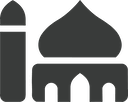A Stockholm mosque was the target of an ‘extensive’ graffiti attack last Friday, according to the mosque’s imam, Mahmoud Khalfi.
On the morning of January 20, the Facebook page of the Stockholm mosque (Stockholms Moské), uploaded several photos of the swastika graffiti on the doors of the mosque.
The vandalism echoes a similar campaign of race hate on New Year’s Day in 2014, as vandals daubed the doors of the mosque with swastika graffiti.
When asked on Facebook if the mosque has CCTV of the incident, a reply stated that the mosque had its request for CCTV denied.
In previous years vandals have targeted other mosques in Sweden with swastika graffiti.
Arson attacks have also taken place in recent years. Following a succession of attacks in 2015, a 1000-strong protest outside of the Swedish parliament in Stockholm drew global attention to the issue. A ‘love bombing’ of the Uppsala Mosque formed part of a wave of support from across Sweden and globally. An investigation in April 2015, however, concluded that the fire at Eskilstuna mosque was not an arson.
Two-thirds of Muslim associations had their buildings vandalised, according to a hate crime survey in 2014.
An attack on a mosque in the southern Swedish city of Karlstad was hit with ‘explosives reinforced with bb pellets,’ according to Abdihakem Adan, who chairs the mosque, on December 26, 2017, which the police are treating as a hate crime, according to reports.
The backlash to the terror attack in Stockholm last April included an unprovoked attack on a Muslim taxi driver by a man who blamed Sweden’s openness to refugees for the attack. Rakhmat Akilov, who later admitted to the terrorist crime, after the truck attack in Stockholm had killed four and injured 15 in April 2017.
Abdi Dahir told Reuters that he feared for his life after being strangled hours after news of the attack broke. Sweden’s security services increased its monitoring of white supremacist groups fearing reprisal attacks, according to Reuters.
The threat from the far-right extends to other minorities in Sweden. In April 2017, the Neo-Nazi group Nordfront forced a Jewish community association in northern Sweden to close following a series of threats. Its building was vandalised with stickers of swastikas and threats such as “we know where you live” were daubed on the building, according to reports in the Swedish press.
A man linked to the neo-Nazi Nordic Resistance Movement drove into a crowd of Iraqi nationals who were protesting outside of the Migration Agency in Malmö in June 2017. It resulted in no major injuries.
Early last year, Swedish police had arrested three suspected neo-Nazis in connection with a spate of bomb attacks on asylum centres and a left-wing bookstore.
The tightening of immigration laws and rejection of asylum applications has had severe medical consequences for some refugees in Sweden. A report in PRI documented “uppgivenhetssyndrom,” or resignation syndrome, where individuals refuse to eat or move, resulting in extended medical stays.
Some municipalities in Sweden are now keeping the location of temporary shelters for asylum seekers secret following the rise in suspected arson attacks.





